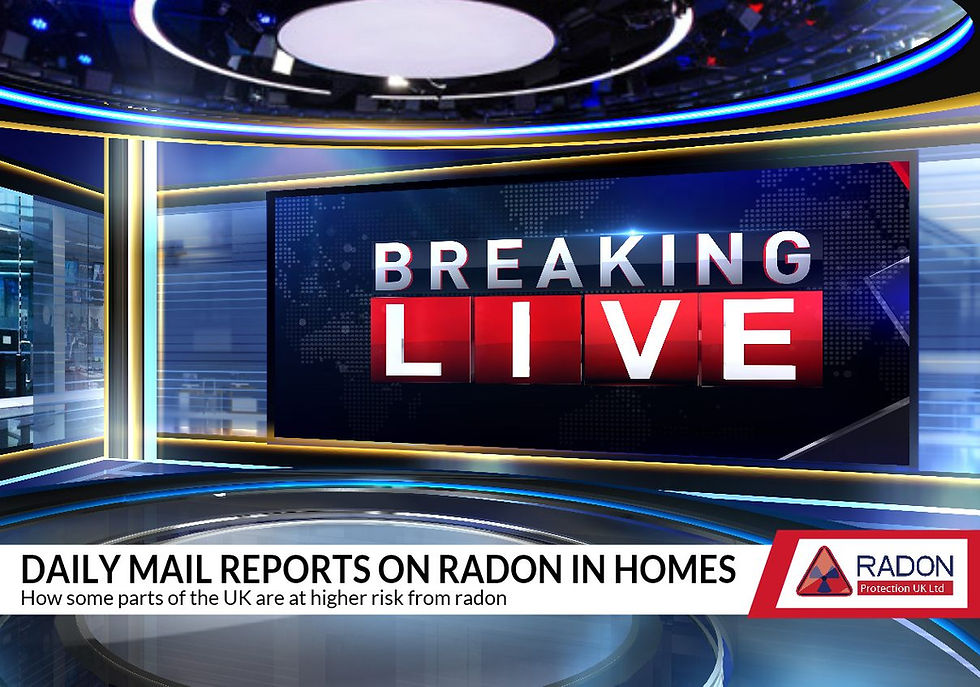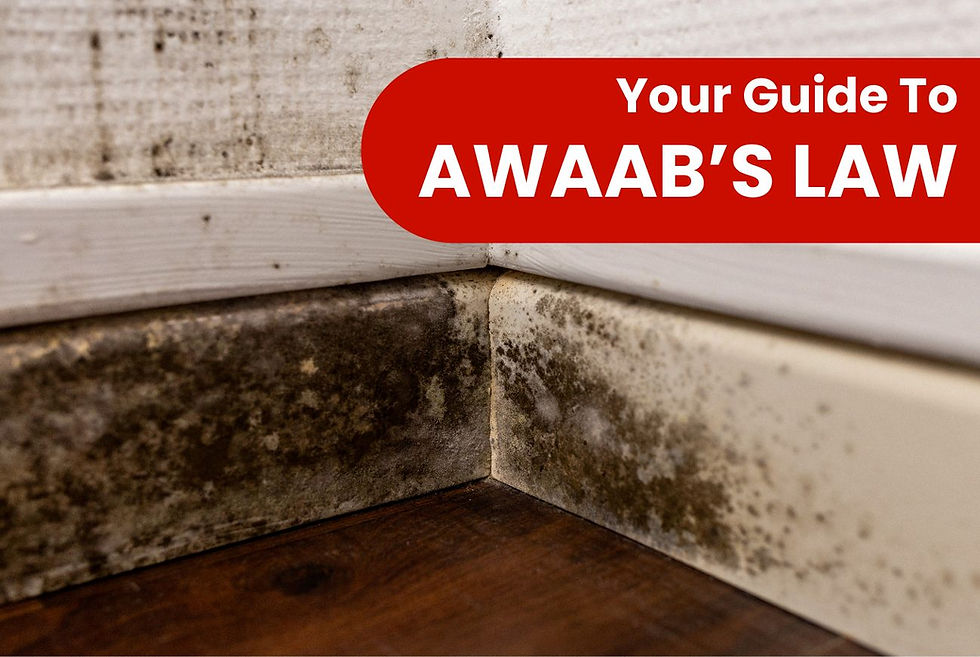Radon Gas in the UK: Why Homes and Schools Are Most at Risk
- sarah11342
- Oct 12
- 4 min read
Why is radon gas a hidden risk in the UK?
Radon is a naturally occurring radioactive gas formed through the decay of uranium in soil and rocks across the UK. It is colourless, odourless, and tasteless, making it undetectable without testing. Radon can accumulate indoors, especially in poorly ventilated buildings, posing an invisible health hazard. This gas is particularly a concern in UK homes and schools, where occupants spend long periods UK Health Security Agency (UKHSA) UK Radon Association.
Why are UK homes particularly at risk from radon gas?
Radon gas seeps into homes and buildings chiefly through cracks in floors and walls, gaps around service pipes, construction joints, and voids beneath buildings. The risk varies geographically according to the underlying geology; areas with granite and certain sedimentary rocks such as in the Midlands, South West, Wales, Cumbria, and Northumberland have higher radon concentrations UK Radon Maps.
Areas deemed as having ‘very high’ concentration are the Midlands, Derbyshire, Oxfordshire, Rutland and Northamptonshire.
Many UK homes have radon levels below the national action level of 200 Bq/m³, but some exceed this and require mitigation.
Radon exposure in homes contributes to approximately 1,100 lung cancer deaths annually in the UK, making it the second leading cause after smoking UKHSA Radon Report.
Home construction type, ventilation, and ground conditions all influence indoor radon concentration.
Why are UK schools particularly at risk from radon gas?
Schools are at risk of radon exposure for similar reasons to homes but with additional factors increasing the concern:
Schools in high radon areas with basements or ground floors built on radon-prone soils can accumulate significant radon concentrations.
Children and staff typically spend many hours in these buildings, increasing their duration of exposure UK Radon Association.
Many schools lack adequate ventilation or radon protective measures, exposing occupants to health risks.
The UK government’s regulations for new school buildings and extensions in radon-affected areas require radon mitigation measures such as Positive Input Ventilation (PIV) systems or radon sumps Building Research Establishment (BRE).
What are the health risks related to radon exposure?
Radon is the leading source of ionising radiation exposure in the UK’s indoor environments. The main risk is lung cancer, caused by inhaling radon decay products which damage lung tissues.
Exposure to radon increases lung cancer risk by about 16% for every 100 Bq/m³ increase in radon concentration Health Protection Agency (HPA).
Smoking compounded with radon exposure significantly amplifies lung cancer risk; smokers exposed to high radon levels are at the greatest risk UKHSA.
There is currently no strong evidence linking radon to cancers other than lung cancer UK Advisory Group on Ionising Radiation (AGIR).
The UK’s radon action level of 200 Bq/m³ is set to minimise risk while recognising that radon cannot be entirely eliminated indoors.
How is radon testing carried out in UK homes and schools?
Radon testing is essential to assess exposure as radon cannot be detected without specialised devices. Testing usually involves:
Placement of detectors: Passive detectors are placed in the most regularly used rooms such as the lounge/ living area and main bedroom in homes. It is important to test the basements and ground floors where radon builds up, typically over a minimum of three months to capture long-term average levels.
Analysis: Detectors are sent to accredited UK laboratories for measurement and evaluation of the radon concentration in Becquerels per cubic metre (Bq/m³).
Interpreting results: Radon levels exceeding 200 Bq/m³ in homes warrant mitigation action according to UK guidelines UK Radon Association Testing Guidance.
Testing Schools – monitors should be placed in occupied areas where radon is likely to accumulate, such as Basements, Offices, Staff Room, Classrooms, Reception, Sports Halls, Dining Areas.
Areas such as storage cupboards and corridors sometimes give anomalous results and should be avoided for testing.
Interpreting results: If the annual average radon level in a workplace exceeds 300 Bq m-3 in any location, warrant mitigation action according to UK guidelines.
Schools and workplaces in radon-affected areas are recommended or required to undertake testing regularly UKHSA Guidance.
What radon mitigation methods are available in the UK?
Several effective methods are used to reduce radon levels inside buildings:
Radon sump systems: These involve installing a sub-floor ventilation system that actively extracts radon gas from beneath the building to the outside, preventing entry indoors UK Radon Association.
Positive Input Ventilation (PIV): This system introduces filtered, fresh air into the building to dilute indoor radon levels while increasing ventilation to remove radon gas Building Research Establishment.
Sealing entry routes: Cracks and gaps in floors and walls are sealed to reduce radon entry, usually combined with other mitigation techniques.
Improved ventilation: Enhancing natural or mechanical ventilation helps reduce radon concentration especially in rooms where it may accumulate.
These mitigation methods are long-lasting, cost-effective, and designed to meet the requirements set by UK regulations including the Ionising Radiations Regulations 2017 (IRR17) HSE IRR17.
What should UK homeowners, tenants, and schools do next?
Radon gas in the UK remains a significant but often overlooked health risk in many homes and schools. Testing is the only way to identify elevated radon levels and assess exposure safely. Where levels exceed the recommended action threshold of 200 Bq/m³, professional radon mitigation through radon sump systems, Positive Input Ventilation (PIV), and sealing can effectively reduce risk.
For expert advice, radon testing, and mitigation services, contact Radon Protection UK to protect the health of your family, staff, and students.
Frequently Asked Questions (FAQs)
What is radon gas? Radon is a naturally occurring radioactive gas produced by the breakdown of uranium in soil and rocks. It is invisible and harmless outdoors but can build up to harmful levels indoors.
How does radon enter buildings? Radon enters through cracks in floors, walls, gaps around pipes, and other openings in the building’s foundation.
What are the health risks of radon? Radon exposure increases the risk of lung cancer, especially for smokers. It is the second leading cause of lung cancer after smoking in the UK.
How is radon testing done? Testing involves placing a radon detector in the most occupied areas for 3 months or more, then sending it for laboratory analysis.
What radon mitigation methods are commonly used? Approved methods include radon sump systems to vent radon below the building, Positive Input Ventilation (PIV), sealing entry points, and improving ventilation.
#radonawareness #radongasUK #homesafetyUK #radoninschools #radonmitigation #RadonProtectionUK #UKradon #radontesting #lungcancerawareness #HSE #UKHSA #breUK #IRR17 #EnvironmentalSafety #IndoorAirQuality #PublicHealthUK #SafeSchoolsUK #HomeSafetyFirst #RadonReduction #HealthAndSafety






Comments